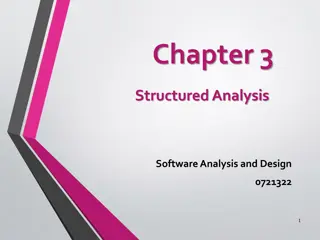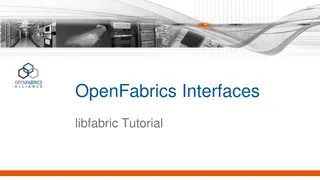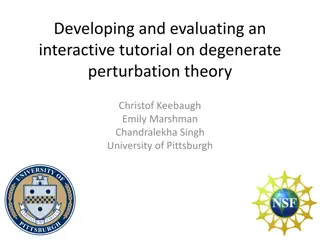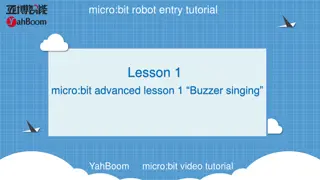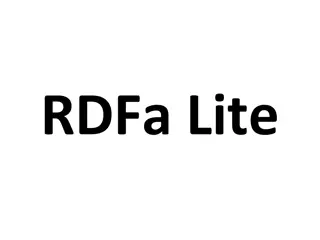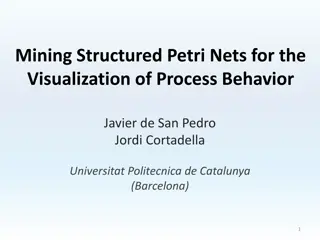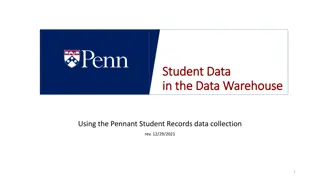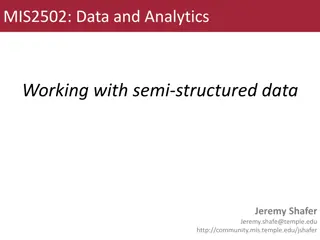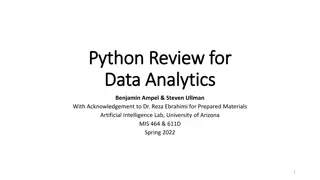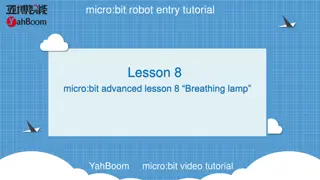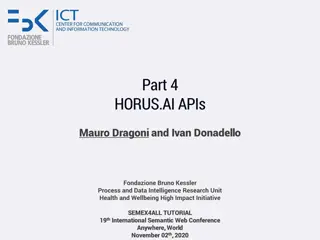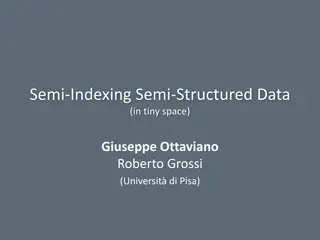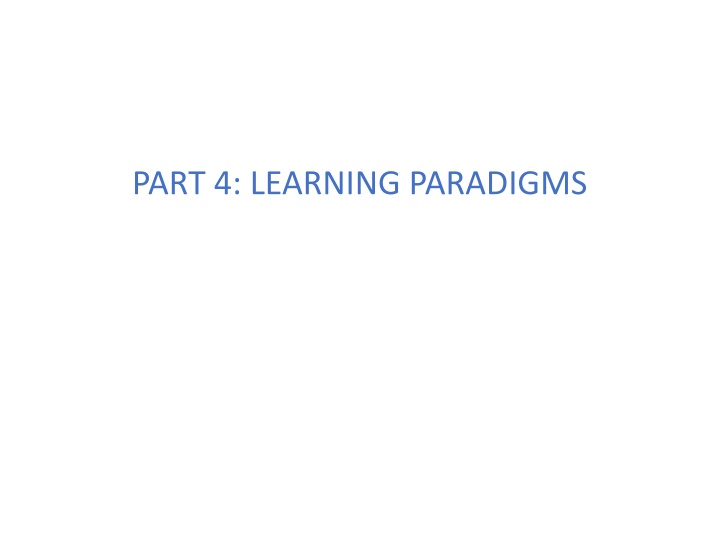
Structured Prediction Learning Paradigms in Natural Language Processing
Explore ILP formulations in NLP focusing on structured prediction learning paradigms. Learn about the motivation behind multiclass classification, different learning approaches, and the challenges of inferring structured outputs in NLP tasks.
Download Presentation

Please find below an Image/Link to download the presentation.
The content on the website is provided AS IS for your information and personal use only. It may not be sold, licensed, or shared on other websites without obtaining consent from the author. If you encounter any issues during the download, it is possible that the publisher has removed the file from their server.
You are allowed to download the files provided on this website for personal or commercial use, subject to the condition that they are used lawfully. All files are the property of their respective owners.
The content on the website is provided AS IS for your information and personal use only. It may not be sold, licensed, or shared on other websites without obtaining consent from the author.
E N D
Presentation Transcript
ILP Formulations in NLP Part 4: Learning Paradigms [30 min] Motivation Multiclass Classification Learning Approaches Independently of constraints (L+I); Jointly (Global) Learning (with constraints) (IBT) Examples Extended SRL 2 Roth & Srikumar: ILP formulations in Natural Language Processing
Structured Prediction: Inference Placing in context: a very high level view of what you will see next Inference: given input x (a document, a sentence), predict the best structure y= {y1,y2, ,yn} 2 Y (entities & relations) Assign values to the y1,y2, ,yn, accounting for dependencies among yis Inference is expressed as a maximization of a scoring function y = argmaxy 2 Y wT (x,y) Joint features on inputs and outputs Set of allowed structures Feature Weights (estimated during learning) Inference requires, in principle, touching all y 2 Y at decision time, when we are given x 2 X and attempt to determine the best y 2 Y for it, given w For some structures, inference is computationally easy. Eg: Using the Viterbi algorithm In general, NP-hard (can be formulated as an ILP) 3 Roth & Srikumar: ILP formulations in Natural Language Processing
Structured Prediction: Learning Learning: given a set of structured examples {(x,y)} find a scoring function w that minimizes empirical loss. Learning is thus driven by the attempt to find a weight vector w such that for each given annotated example (xi, yi): 4 Roth & Srikumar: ILP formulations in Natural Language Processing
Structured Prediction: Learning Learning: given a set of structured examples {(x,y)} find a scoring function w that minimizes empirical loss. Learning is thus driven by the attempt to find a weight vector w such that for each given annotated example (xi, yi): Penalty for predicting other structure Score of annotated structure Score of any other structure 8 y We call these conditions the learning constraints. In most learning algorithms used today, the update of the weight vector w is done in an on-line fashion, Think about it as Perceptron; this procedure applies to Structured Perceptron, CRFs, Linear Structured SVM W.l.o.g. (almost) we can thus write the generic structured learning algorithm as follows: 5 Roth & Srikumar: ILP formulations in Natural Language Processing
Structured Prediction: Learning Algorithm In the structured case, prediction (inference) is often intractable but needs to be done many times For each example (xi, yi) Do: (with the current weight vector w) Predict: perform Inference with the current weight vector yi = argmaxy 2 Y wT ( xi ,y) Check the learning constraints Is the score of the current prediction better than of (xi, yi)? If Yes a mistaken prediction Update w Otherwise: no need to update w on this example EndFor 6 Roth & Srikumar: ILP formulations in Natural Language Processing
Structured Prediction: Learning Algorithm Solution I: decompose the scoring function to EASY and HARD parts For each example (xi, yi) Do: Predict: perform Inference with the current weight vector yi = argmaxy 2 Y wEASYT EASY ( xi ,y) + wHARDT HARD ( xi ,y) Check the learning constraint Is the score of the current prediction better than of (xi, yi)? If Yes a mistaken prediction Update w Otherwise: no need to update w on this example EndDo EASY: could be feature functions that correspond to an HMM, a linear CRF, or even EASY (x,y) = (x), omiting dependence on y, corresponding to classifiers. May not be enough if the HARD part is still part of each inference step. 7 Roth & Srikumar: ILP formulations in Natural Language Processing
Solution II: Disregard some of the dependencies: assume a simple model. Structured Prediction: Learning Algorithm For each example (xi, yi) Do: Predict: perform Inference with the current weight vector yi = argmaxy 2 Y wEASYT EASY ( xi ,y) + wHARDT HARD ( xi ,y) Check the learning constraint Is the score of the current prediction better than of (xi, yi)? If Yes a mistaken prediction Update w Otherwise: no need to update w on this example EndDo 8 Roth & Srikumar: ILP formulations in Natural Language Processing
Structured Prediction: Learning Algorithm Solution III: Disregard some of the dependencies during learning; take into account at decision time For each example (xi, yi) Do: Predict: perform Inference with the current weight vector yi = argmaxy 2 Y wEASYT EASY ( xi ,y) + wHARDT HARD ( xi ,y) Check the learning constraint Is the score of the current prediction better than of (xi, yi)? If Yes a mistaken prediction Update w Otherwise: no need to update w on this example EndDo yi = argmaxy 2 Y wEASYT EASY ( xi ,y) + wHARDT HARD ( xi ,y) This is the most commonly used solution in NLP today 9 Roth & Srikumar: ILP formulations in Natural Language Processing
Constrained Conditional Models Any MAP problem w.r.t. any probabilistic model, can be formulated Penalty for violating the constraint. as an ILP [Roth+ 04, Taskar 04] Variables are models y = argmaxy 1 (x,y)wx,y subject to Constraints C(x,y) y = argmaxy 2 Y wT (x, y) + uTC(x, y) Knowledge component: (Soft) constraints Weight Vector for local models Features, classifiers (Lin; NN); log-linear models (HMM, CRF) or a combination How far y is from E.g., an entities model; a relations model. a legal/expected assignment Training: learning the objective function (w, u) Decouple? Decompose? Force u to model hard constraints? Inference: A way to push the learned model to satisfy our output expectations (or expectations from a latent representation) How? [CoDL, Chang, Ratinov, Roth (07, 12); Posterior Regularization, Ganchev et. al (10); Unified EM (Samdani & Roth(12), dozens of applications in NLP] The benefits of thinking about it as an ILP are conceptual and computational. 10 Roth & Srikumar: ILP formulations in Natural Language Processing
Where are we? Modeling & Algorithms for Incorporating Constraints Showed that CCMs support formalizing many problems Showed several ways to incorporate global constraints in the decision. Training: Coupling vs. Decoupling Training and Inference. Incorporating global constraints is important but Should it be done only at evaluation time or also at training time? How to decompose the objective function and train in parts? Issues related to: Modularity, efficiency and performance, availability of training data Problem specific considerations 11 Roth & Srikumar: ILP formulations in Natural Language Processing
Training Constrained Conditional Models Decompose Model Decompose Model from constraints Learning paradigms Independently of the constraints (L+I) Jointly, in the presence of the constraints (IBT) Decomposed to simpler models Note that structured prediction algorithms can be used in both paradigms When we decide to learn jointly When the left part is structured but we still want to add additional constraints only at inference time It is possible to train a model (left side), but make decisions with additional information (right side) that was not incorporated during learning model. (Not available, not needed, or just too expensive) Roth & Srikumar: ILP formulations in Natural Language Processing 12
Learning Paradigms [Punyakanok+ 05] Local Learning Learning local models independently: ignore constraints during training Ensure output is coherent at test time E.g., One-against-all multiclass classification Global Learning Learning with inference: consider constraints during training Training and test are consistent E.g., constrained classification for multiclass; multiclass SVM [Har-Peled et. el 2002; Crammer et. al 2002] Question: Isn t global always better? Not so simple Next, the Local model story 13 Roth & Srikumar: ILP formulations in Natural Language Processing
Multiclass Classification From the full dataset, construct three binary classifiers, one for each class wblueTx > 0 for blueinputs worgTx > 0 for orange inputs wblackTx > 0 for black inputs Notation: Score for blue label Winner Take All will predict the right answer. Only the correct label will have a positive score 14 Roth & Srikumar: ILP formulations in Natural Language Processing
One-vs-all may not always work Red points are not separable with a single binary classifier The decomposition is not expressive enough! wblueTx > 0 for blue inputs worgTx > 0 for orange inputs wblackTx > 0 for black inputs ??? 15 Roth & Srikumar: ILP formulations in Natural Language Processing
Local Learning: One-vs-all classification Easy to learn Use any binary classifier learning algorithm Potential Problems Calibration issues We are comparing scores produced by K classifiers trained independently. No reason for the scores to be in the same numerical range! Train vs. Train Does not account for how the final predictor will be used Does not optimize any global measure of correctness Yet, works fairly well In most cases, especially in high dimensional problems (everything is already linearly separable). 16 Roth & Srikumar: ILP formulations in Natural Language Processing
Global Multiclass Approach [Constraint Classification, Har-Peled et. al 02] Create K classifiers w1, w2, , wK. ; Predict with WTA: argmaxiwiTx But, train differently: For examples with label i, we want Training: For each training example (??,??) : ? ???max ? if ? ?? ??? ???+ ??? ? ? ? ? ???(demote) wiTx > wjTx for all j ??(??,??) ?? ?: learning rate (promote) 17 Roth & Srikumar: ILP formulations in Natural Language Processing
Moving to Structures: Training Methods Learning + Inference (L+I) Learn models independently y2 y3 y1 f1(x x) y4 Inference Based Training (IBT) Learn one model, all y s together! f2(x x) y5 f3(x x) Y Y f4(x x) x3 Intuition: Learning with constraints may make learning more difficult x4 f5(x x) x1 x5 x2 X X x7 x6 18 Roth & Srikumar: ILP formulations in Natural Language Processing
Training with Constraints: Joint (Global) Learning; IBT Both procedures can be used with any local model f (including a structured model, NN, .) True Global Labeling: Y Y - -1 1 1 1 - -1 1 - -1 1 1 1 Local Predictions: Y Y Y Y - -1 1 - -1 1 1 1 1 1 1 1 - -1 1 1 1 1 1 1 1 1 1 Apply Constraints (Inference): f1(x x) X X f2(x x) x3 f3(x x) Y Y x4 f4(x x) x1 x5 f5(x x) x2 Which one is better? When and Why? x7 x6 19 Roth & Srikumar: ILP formulations in Natural Language Processing
L+I & IBT: General View Structured Perceptron Graphics for the case: F(x,y) = F(x) For each iteration For each (X, YGOLD ) in the training data Y YPRED If YPRED != YGOLD = + F(X, YGOLD ) - F(X, YPRED) ( , ) = ( , ) + (X, YGOLD ) (X, YPRED) endif endfor with constraints) PRED= The difference between L+I and IBT In IBT, can also train ( augments feature vector 20 Roth & Srikumar: ILP formulations in Natural Language Processing
Claims[Punyakanok et. al , IJCAI 2005] Theory applies to the case of local models F(x,y) = F(x ); applies broadly, e.g., SRL When the local modes are easy to learn, L+I outperforms IBT. In many applications, the components are identifiable and easy to learn (e.g., argument, open-close, PER). Only when the local problems become difficult to solve in isolation, IBT outperforms L+I, but needs a larger number of training examples. L+I: cheaper computationally; modular IBT is better in the limit, and when there is strong interaction among y s Other training paradigms are possible Pipeline-like Sequential Models: [Roth, Small, Titov: AI&Stat 09] Identify a preferred ordering among components Learn k-th model jointly with previously learned models Constrained Driven Learning [Chang et. al 07,12; later] 21 Roth & Srikumar: ILP formulations in Natural Language Processing
L+I vs IBT L+I vs. IBT: the more identifiable individual problems are, the better overall performance is with L+I opt + ( ( d log m + log 1/ ) / m )1/2 0 + ( ( cd log m + c2d + log 1/ ) / m )1/2 Local Global Indication for hardness of problem Bounds Simulated Data Accuracy Accuracy opt=0.1 opt=0 opt=0.2 # of Examples # of Examples 22 Roth & Srikumar: ILP formulations in Natural Language Processing
Relative Merits: SRL In some cases problems are hard due to lack of training data. Semi-supervised learning L+I is better. When the problem is artificially made harder, the tradeoff is clearer. Difficulty of the learning problem (# features) Roth & Srikumar: ILP formulations in Natural Language Processing hard easy 23
Learning Paradigms: Summary So far, we discussed some Pros & Cons for when to use each Joint (Global; IBT) More expressive; better in the limit More expensive computationally Requires more examples Decoupled (L+I) Simpler, more modular. More flexible; gives rise to compositionality Better if local components are individually good. But, sometimes there is no choice Lack of jointly labeled data Constraints appearing only at evaluation time 24 Roth & Srikumar: ILP formulations in Natural Language Processing
Archetypical Information Extraction Problem: E.g., Concept Identification and Typing, Event Identification, etc. Semantic Role Labeling (SRL) I left my pearls to my daughter in my will . [I]A0left [my pearls]A1 [to my daughter]A2 [in my will]AM-LOC . A0 A1 A2 AM-LOC Location Leaver Things left Benefactor I left my pearls to my daughter in my will . 25 Roth & Srikumar: ILP formulations in Natural Language Processing
Verb SRL is not Sufficient John, a fast-rising politician, slept on the train to Chicago. Verb Predicate: sleep Sleeper: John, a fast-rising politician Location: on the train to Chicago Who was John? Relation: Apposition (comma) John, a fast-rising politician What was John s destination? Relation: Destination (preposition) train to Chicago 26 Roth & Srikumar: ILP formulations in Natural Language Processing
Extended Semantic Role Labeling Many predicates; many roles; how to deal with more phenomena? Sentence level analysis may be influenced by other sentences 27 Roth & Srikumar: ILP formulations in Natural Language Processing
Computational Challenges Predict the [preposition] relations [EMNLP, 11] Identify the relation s arguments [PP: Trans. Of ACL, 13, Comma: AAAI 16] Very little supervised data per phenomena Minimal annotation only at the predicate level Learning models in these settings exploits two principles: Latent structure can be constrained (via CCMs) Coherency among multiple phenomena: learn simple models; infer together 28 Roth & Srikumar: ILP formulations in Natural Language Processing
Coherency in Semantic Role Labeling Predicate-arguments generated should be consistent across phenomena The touchdown scored by Brady cemented the victory of the Patriots. Verb Nominalization Preposition Predicate: score Predicate: win Sense: 11(6) the object of the preposition is the object of the underlying verb of the nominalization A0: Brady (scorer) A1: The touchdown (points scored) A0: the Patriots (winner) Linguistic Constraints: A0: the Patriots Sense(of): 11(6) A0: Brady Sense(by): 1(1) 29 Roth & Srikumar: ILP formulations in Natural Language Processing
Enforce Coherence via Joint inference (CCMs) Variable ya,t indicates whether candidate argument a is assigned a label t. ca,t is the corresponding model score Verb arguments Preposition relations + . Argument candidates Preposition relation label Re-scaling parameters (one per label) Constraints: Preposition Each argument label Verb SRL constraints Preposition SRL Constraints + Joint constraints between tasks How to learn the coefficients of different components? Either use a little bit of jointly labeled data, or learn scaling coefficients without jointly annotated data Roth & Srikumar: ILP formulations in Natural Language Processing 30
Training Complex Models without Joint Supervision Verbs Nouns Commas Prepositions Compounds Possessives Adjective-Noun Light verbs Phrasal verbs NER Wikification Events Implicit relations Missing Arguments Missing Predicates Conjunctions Quantifiers Negations Quantities (comparators) Temporal There is a need to understand multiple phenomena in natural language text We will never have enough jointly annotated data Joint inference via declarative constraints Is essential both to provide coherent structured prediction, and At a way to get around lack of joint annotation Lack of data is also our starting point for the next section, on Constraint Driven Learning. 31 Roth & Srikumar: ILP formulations in Natural Language Processing

